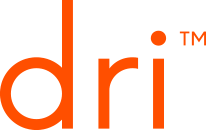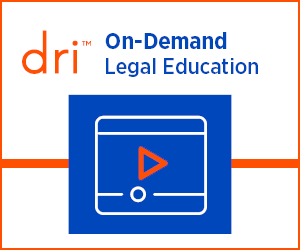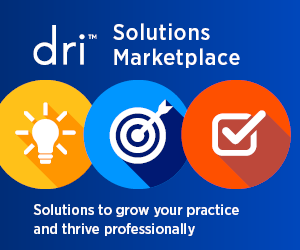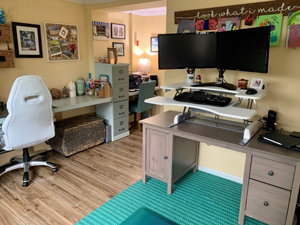Shifting the Burden
Diversity, Equity, and Inclusion in Law Firms and Corporate Legal Departments

By Chelsea Dease, Akiesha Gilcrist Sainvil, and Enjoliqué Aytch Lett
One would be hard-pressed to find a lawyer, law firm, or corporate legal department that is not keenly aware of the issue of diversity, or lack thereof, in the legal profession—particularly with respect to recruitment, retention, and promotion of diverse lawyers (referring to women, ethnic minorities, and any group historically underrepresented in the legal field). Many organizations, to their credit, are working to rectify this issue through formalized programming, referred to as Diversity, Equity & Inclusion (DE&I) efforts.
DE&I is a well-meaning concept, but without thoughtful and effective policies that integrate DE&I into the fabric of corporate culture, it will fall woefully short of tipping the scales in favor of equity. To truly pay homage to the concept of DE&I, we need to ask ourselves tough questions and be brutally honest about what DE&I in the law firm setting looks like. Those questions include: Upon whom should the burden of DE&I implementation fall? Who is ultimately being asked to shoulder the load and at what cost? How many non-diverse attorneys attend DE&I programming? Are the people who do participate in and purposefully advance the DE&I mission involved in pivotal conversations concerning equity, profitability, client relations, and succession planning? Is there a mechanism by which DE&I achievements are being measured? Who will be held accountable if DE&I goals are not met?
The “burdens” of implementation often fall on those for whom the programming is designed to benefit. Individuals spearheading DE&I efforts “preach to the choir” on such issues—meaning those who willingly take part in the DE&I conversation are often also those individuals historically left out of the “conversation,” or those who already understand and truly wish to advance DE&I efforts, but may not be in a position to play a meaningful role in key advancement and compensation decisions. Fortunately, many law firms and corporate organizations recognize this as well, and have developed initiatives to tackle these issues head on.
Law Firms Striving Toward Diversity, Equity, & Inclusion
In the law firm context, billable hours are key, as they typically set the baseline standard for compensation, promotion, and bonus determinations for lawyers. It can be trying for any lawyer to get, hit, and maintain billable hours, particularly when one considers all of the usual distractions a typical lawyer faces on a day-to-day basis at work—in addition to their familial and extracurricular activities. Many lawyers are stretched thin and asking them to pile just one more thing on their plate, no matter how well-intentioned and necessary, can be difficult. Thus, DE&I activities, as with anything above and beyond a lawyer’s typical activities, (particularly if they may not weigh on compensation or promotion) can understandably fall to the wayside. When those activities appear to result in minimal change, as can be the case where DE&I activities are organized by and attended only by diverse attorneys and their like-minded counterparts, the added requirement can feel even more burdensome.
Previously, diverse lawyers were often the first to be called on to implement, assist with implementing, or to participate in DE&I programming and initiatives. It takes very little imagination, then, to understand the conundrum diverse lawyers faced in having a personal proclivity toward DE&I activities, feeling compelled to participate in DE&I activities when asked (not to suggest that the “ask” alone is a problem), and needing to balance all of the usual daily activities as our peers, while also maintaining billable hours. Adding insult to injury, the time spent on such activities—while demonstrating “good firm citizenship”—rarely translated into moving the needle in terms of compensation or promotion.
Fortunately, many law firms have now shifted to a paradigm that offers billable hour credit for DE&I activities. The actual requirements vary from firm to firm, but typically some kind of participation in organizations and activities that support the core principles of diversity, equality, equity, and/or inclusion—such as targeted recruiting efforts, mentorship, attending or participating in the planning of DE&I-related events, and holding leadership roles in diversity-focused organizations—will satisfy that credit. The hope is that giving such credit incentivizes all attorneys to participate and engage in difficult conversations and do the “good work,” with the reward of satisfying billable hour metrics in the process. It also evens the playing field, at least somewhat, for those lawyers faced with the “burden” of being asked to participate in such activities more often than others.
On a larger and outward scale, law firms have demonstrated their personal commitment to promoting DE&I through their participation in organizations like the Leadership Council on Legal Diversity and the Move the Needle Fund, through recruitment at diversity-oriented events and pipeline programs, and signing on to the Mansfield Rule, which requires that a firm measure whether at least a certain percentage of women, attorneys of color, LGBTQ+ individuals, and lawyers with disabilities have been considered for leadership roles, promotions, client opportunities, and senior lateral openings. Many law firms today have also hired Chief Diversity Officers to lead departments dedicated to DE&I efforts, with special emphasis on having conversations around and answering the “hard questions” noted above.
Corporate Legal Departments Taking Law Firms to Task
Corporate legal departments have expressed similar sentiment with respect to DE&I efforts, both internally and for their outside law firm counsel. Indeed, many in-house legal departments recognize that fostering diversity in the legal profession makes good business sense. They acknowledge that diversity will play a significant role in the overall success of their organizations. This is especially so in light of their necessarily diverse consumer bases.
Internally, in-house legal departments have increased diversity through recruitment and participation in their organizations’ internal DE&I programs. In support of these efforts, these organizations are reported to have conducted internal assessments of their legal departments, with an emphasis on increasing the number of women and minority attorneys hired to reflect a more accurate representation of the communities they serve.
In-house legal departments have also been vocal in encouraging DE&I efforts at the law firms which they engage. Corporate legal departments have been partnering with their outside counsel to sponsor such programming and previously stated their desire for a more diverse slate of attorneys to work on their matters. Having noted that those desires did not result in a quantitative or qualitative movement toward a more equitable and inclusive goal for their outside counsel, many have now established measurable guidelines for tracking whether and to what extent their outside counsel are meeting certain DE&I standards. Those guidelines can take many forms, but a few of the more comprehensive ones have included diversity data, billable time commitments, and relationship-matter credit disclosure requirements. Legal departments also actively seek to identify and retain women- and minority-owned outside law firms. For example, many top corporations take part in DRI’s Diversity for Success Corporate Expo, which provides a unique opportunity for selected minority and women attorneys and their law firms to network and interview with corporations and insurance companies committed to diversifying their national outside counsel panels.
The Road Ahead
Law firms and corporate legal departments have obviously taken steps in the right direction to identify and correct the longstanding issue surrounding recruitment, retention, and promotion of diverse lawyers in the legal field. Thus, the legal field may be beyond the stage of identifying the problem and developing solution-based initiatives. Where we must focus and continue to require measurable change is in the enactment, implementation, and evaluation of these initiatives to ensure that we are developing a more equitable and inclusive profession.
 Chelsea M. Dease is an associate attorney in Greenberg Traurig’s Atlanta office representing pharmaceutical companies and medical device manufacturers in product liability cases, as well as hospitals and medical professionals in professional liability cases. She helps advise companies on regulatory, compliance, and risk management matters, including adverse event reporting and patient inquiries/claims.
Chelsea M. Dease is an associate attorney in Greenberg Traurig’s Atlanta office representing pharmaceutical companies and medical device manufacturers in product liability cases, as well as hospitals and medical professionals in professional liability cases. She helps advise companies on regulatory, compliance, and risk management matters, including adverse event reporting and patient inquiries/claims.
 Akiesha Gilcrist Sainvil is an associate attorney in Greenberg Traurig’s Miami office, where she centers her practice on defending medical device, pharmaceutical, and consumer products manufacturers in high-stakes complex products liability and mass torts litigation. She has also defended major retailers, transportation companies, financial and health care institutions, and insurance providers in complex commercial litigation matters in federal and state courts in the United States.
Akiesha Gilcrist Sainvil is an associate attorney in Greenberg Traurig’s Miami office, where she centers her practice on defending medical device, pharmaceutical, and consumer products manufacturers in high-stakes complex products liability and mass torts litigation. She has also defended major retailers, transportation companies, financial and health care institutions, and insurance providers in complex commercial litigation matters in federal and state courts in the United States.
 Enjoliqué Aytch Lett is a shareholder in Greenberg Traurig’s Miami office, focusing her practice on pharmaceutical, medical device and health care sector litigation. She often leads bet-the-company litigation for clients in the drug and medical device manufacturing industries. She is also well experienced in mass tort and multi-district litigation, and also has substantial experience defending high-exposure medical malpractice actions for physicians and hospitals.
Enjoliqué Aytch Lett is a shareholder in Greenberg Traurig’s Miami office, focusing her practice on pharmaceutical, medical device and health care sector litigation. She often leads bet-the-company litigation for clients in the drug and medical device manufacturing industries. She is also well experienced in mass tort and multi-district litigation, and also has substantial experience defending high-exposure medical malpractice actions for physicians and hospitals.









 Photo Credit: Collection of the Supreme Court of the United States
Photo Credit: Collection of the Supreme Court of the United States












